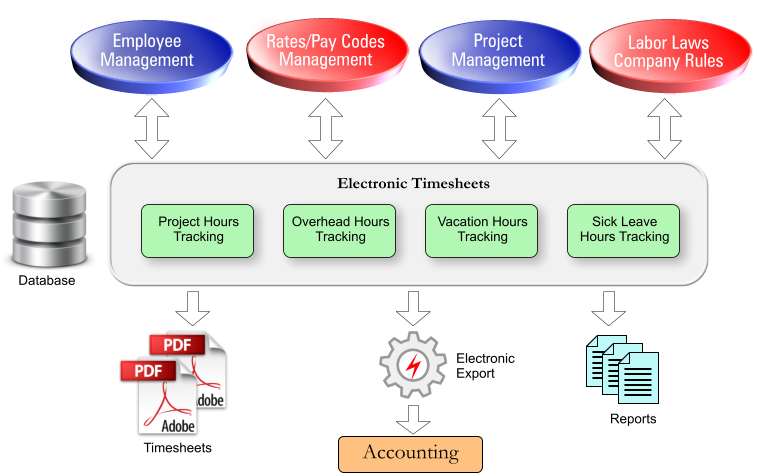Web-based Timesheet Management

Easy to use timesheet management system replaces the traditional paper-based way of recording employees’ time. It provides a far more accurate way of keeping track of regular and overtime hours in accordance with labor laws and company rules and protocols. In addition, all timesheets are kept in a database for historical and auditing requirements. Its error checking algorithms detect inaccuracies at every stage of the process flow.
Cloud-based applications offer several advantages over traditional ones. They provide better accessibility, scalability, and lower cost of ownership. Our team has vast experience in software development methodologies and languages. With 30 years of software development under our belt, we have built several large, cloud-based applications and custom intranets.
Features
- Secure SSL Web-based interface
provides access from anywhere in the world. Employees, managers, controllers and accountant have access to the timesheets - Easy to use
A great deal of efforts went into the design of the user interface and the functionality to ensure an easy, fast and accurate data entry. For example each entry has to be a multiple of 15 minutes. Employee only sees the active projects and pay codes that are assigned to him - Cumulative Totals are listed horizontally (per project) and vertically (per day)
- Note for every entry
By double clicking on the cell a pop up note appears. Managers at approval time can read the employee notes but they cannot edit them. In addition a global note is associated for the timesheet itself - Project Management
Keeps track of unlimited number of projects (active and inactive). Each project can have unlimited tasks and sub-tasks associated with it. This granularity gives the manager the flexibility to turn on or off the projects or tasks that can be used at the time. It provides the flexibility of directing the available resources before running out of budget and be subject to reallocation and adjustment at a later date - Employee Management
Each employee is assigned a list of projects he/she is working on thus reducing the amount of projects and pay codes he/she needs to deal with. This in turns reduces the complexity and data entry errors - Multiple approving Managers or persons
Each employee is assigned a list of managers or supervisors who are allowed to approve his/her timesheets
- Pay Code Management
Each project can have unlimited Pay Codes - Keeps track of both projects and overheads
in particular employee vacation and sick leave - Multiple Error checking
is performed at submission time, at approval time and during export data to accounting - Notification of missing timesheets
Approving managers can see the status and of all timesheets in their departments and in one click they can sends an email notification to all employees who have missing or incomplete timesheets - Notification for missing approvals
A controller can view all the timesheets that have not been approved and in one click sends an email notification to assigned approving managers - Access authority to various function is "role based"
Administering the system or access to different reports is based on type of users i.e. managers have access to more reports than employees - Generates PDF Timesheet printout
with option to print the notes or not - Timesheet reports
with filters on employees and/or projects for any time period - Vacation and sick leave reports
- Export to an accounting system
The approved timesheets can be exported as a batch file to an accounting system. Currently a Quickbook interface is available
Timesheet Process Flow

The Employee
The process starts when an employee creates a timesheet. The status of the timesheet starts out as "Pending". Employees can edit their timesheets anytime before submiting, they can do it every day or at the end of the period. When he is done, he submits it. the timesheet can no longer be edited even by the owner. The status becomes "Submitted" .The employee's name and the date are recorded in the timesheet.
The Approving Manager
The approving manager review the data on the timesheet and he can do one of the two options:
1. Approve it and its status becomes "Approved"
2. Reject it.
The manager has the choice of sending a notification email to the employee. The status become "Rejected" and the timesheet becomes editable by its owner who in turn modifies it and re-submits it when done.
The Controller
While the approving manager deals with accuracy of the data, the controller makes sure that all timesheets have been approved and for the missing ones, he can create one on the behave of an absent employee and submit it. The controller name is recorded as the submitter. When all the timesheets are approved, the controller can export all the timesheets to an accounting system in one shot.
